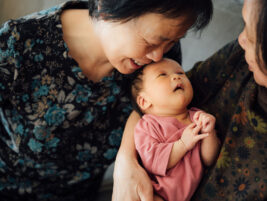Abstract
Each year, nearly 15 million infants are born prematurely worldwide. These infants are exposed to pain, noise and separation during the first weeks of life. The high exposure to pediatric medical traumatic stress places infants and their caregivers at risk for mental health challenges that can persist into adulthood. To advance understanding, early stressors have been studied and linked to the development of later psychopathology. Recognizing these stressors creates a valuable opportunity for prevention through Trauma-Informed Developmental Care (TIDC) and Emotional Revival Therapy (ERT). These approaches equip Infant Mental Health Professionals with effective tools to support premature families and keeping hope up during the NICU journey. These early interventions at NICU help prevent manifest regulatory and attachment disorders in infants as well as perinatal psychiatric disorders in parents.
Key words
Prematurity, Pediatric Medical Traumatic Stress, Trauma-Informed Developmental Care (TIDC), Emotional Revival Therapy (ERT)
Abbreviations
ELS: Early-life stress
ERT: Emotional Revival Therapy
TIDC: Trauma-Informed Developmental Care
PMTS: Pediatric Medical Traumatic Stress
Introduction
Each year, close to 15 million infants are born prematurely worldwide, thrusting families into a world of uncertainty and intense medical intervention (World Health Organization, 2025). The physical and mental development of these vulnerable newborns has long been a central concern in neonatal care. Pioneering research in infant mental health shaped care strategies, emphasizing stress reduction and emotional regulation (Field, 1977; Als, 1982). The positive effects of these interventions have been extensively documented (Givrad et al., 2021). Despite these advances, preterm infants remain at heightened risk for psychiatric disorders from birth into adulthood (Johnson & Marlow, 2011). Johnson and Marlow (2011) describe the “preterm behavioral phenotype” which represents typical psychiatric manifestations of premature born adults characterized by inattention, anxiety, and social difficulties. Early-life stress (ELS), superimposed on immature neural pathways, deranges the developmental trajectory of prematurely born individuals contributing to the emergence of the preterm behavioral phenotype (Schmuecker et al., 2005).
Pediatric Medical Traumatic Stress (PMTS) is a term used to describe the responses of children and their families to trauma within a medical setting (Price, et al., 2016). The suffering during and after intensive care for both baby and parent underscores the importance of Trauma-Informed Developmental Care (TIDC) and Emotional Revival Therapy (ERT) throughout the hospital experience and beyond discharge to reduce the impact of PMTS. These interventions can mitigate the risks of mental health complications, to both baby and family that arise during the NICU stay and span the continuum from early childhood into adulthood. Ideally, these early interventions at NICU and beyond help prevent manifest regulatory disorders in infants, perinatal psychiatric disorders in parents, and disorders within the parent-infant relationship.
The NICU as a Dual Landscape of Healing and Trauma
The NICU is both a sanctuary of survival and a crucible of stress. For the infant, the soundscape of alarms and ventilators, the glare of fluorescent lights, and the invasive touch of medical procedures replace the gentle rhythms of the womb (Wolke, 1991). These sensory intrusions disrupt critical neural and emotion regulatory networks. In the womb, the baby’s sense of self is entirely relational, tied to the mother through a seamless co-regulatory bond that provides both physical and emotional sustenance. Suddenly, that bond is severed, leaving the baby exposed to bright lights and a cacophony of unfamiliar sounds, with so many hands touching, poking, and sticking needles into them. Tubes are inserted down their throat, often without any comforting reassurances or soothing touch. The babies, with no point of reference to understand the life-threatening situation, is left in a state of utter bewilderment and terror.
A state of shock is a natural response to birth that requires life-sustaining medical interventions for baby and mother, which begins when the two are torn apart. This separation is the first in a cascade of events that disrupts the intuitive bond between mother and child and often positions the caregiver(s) as visitors of their baby within the NICU. Imagine yourself as the parent; you are standing outside your baby’s room, separated by a door you cannot open. You must ring the bell and wait for permission to enter before you are then required to disinfect your hands and walk a long corridor before reaching your child. Even then, the natural response to gather your child into your arms and hold them in your loving embrace often depends upon the availability, and the permission of someone else to assist you. The power dynamic in these situations casts a long shadow over the caregiver’s experience. Parents often describe feeling like intruders in their child’s care, rather than being essential to their baby’s survival. Parents who are unable to participate in their child’s care often struggle with feelings of inadequacy and guilt, which can linger long after the NICU experience has ended.
TIDC seeks to mitigate these stressors, reframing the NICU as a place of healing (Coughlin, 2021). Within the context of earlier viability thresholds, TIDC faces new demands to address the heightened vulnerabilities of extremely preterm infants and their families. For parents, family-integrated care models, informed by trauma-informed paradigms, help to rebuild confidence and foster connection that is quintessential to healing. These person-centered paradigms transform the NICU from an alienating environment to one of shared caregiving. By integrating targeted developmental and relational strategies, TIDC aims to mitigate the compounded effects of early adversity.
Pediatric Medical Traumatic Stress: Defining the Experience
The experience of the infant in NICU typifies PMTS, with life threatening conditions, the suffocation associated with pulmonary immaturity, repeated painful procedures and prolonged caregiver separation. Unlike older children, newborns in the NICU lack established routines and memories, making it difficult to distinguish the infant’s baseline behavior profile from their lived experience of trauma. However, common key stressors associated with NICU hospitalization, that include respiratory distress, procedural pain, and separation from caregivers, are known risk factors for psychopathology (Pierrehumbert et al., 2013). Sleep fragmentation and noxious touch experiences, in conjunction with invasive procedures, further exacerbate the infant’s distress. Understanding how these stressors contribute to short and long-term developmental outcomes is essential for creating effective interventions.
Stressors in the NICU Environment
Pulmonary Immaturity: Respiratory distress syndrome is often a preterm infant’s first experience outside the womb, characterized by shallow breathing and grunting. It is a breathing pattern not exclusive to pulmonary immaturity but typical for a state of panic and a pretext to a traumatic development. To ensure the survival of the premature infant mechanical ventilation may follow the respiratory distress which alters physical recovery but also the neural pathways that regulate stress and basal affects. Often the infant experiences mechanical ventilation in a state of drug induced dissociation. Once the infant no longer needs external respiratory support, the pattern of dissociation may have become part of the infant’s neural networks and self-identity (Schore, 2012). Chronic lung conditions as well as early dissociation limits the individual’s quality of life, restricting their physical activities and potentially affecting their capacity for social participation (Lærum et al., 2019). The emotional cost of witnessing an infant’s struggle with respiratory distress weighs heavily on parents and caregivers, adding to their sense of helplessness and potentially influencing their capacity to provide attuned caregiving.
Pain and Procedural Trauma: NICU infants endure numerous painful procedures daily, often without sufficient analgesia (Carbajal et al., 2008). Premature infants respond visibly to this pain with crying, hypertonus and increase of the heart rate (Pokela & Koivisto, 1994). Despite the aversive reaction of the infant, the painful procedures will go on for days to months, often under-managed. The infant’s attempts to withdrawal from the pain results in an enduring state of dissociation. This traumatic state impairs the physiological stability and emotional development of the infant, increasing the risk for developmental disorders (Lammertink et al,. 2022). The long term consequences of early-life exposure to unmanaged pain is associated with altered gene expression linked to greater socio-emotional stress sensitivity and behavioral challenges at school-age (Chau et al., 2014). Pain is a major risk factor for dissociation and a traumatic developmental trajectory, and may pose a risk for disorganized attachment patterns (Wolke et al., 2014).
Separation from Caregivers: Separation exacerbates the infant’s stress, depriving them of co-regulation by and safety with their primary caregivers. For infants, the absence of consistent caregiver presence disrupts the natural rhythms of attachment formation, leaving them in a state of affect dysregulation (Schore, 2012). When this absence occurs under the conditions of life-threatening circumstances and constant medical stress, the opportunity for co-regulation is significantly restricted for the baby and their parent. Private rooms within the NICU setting remain rare and are not a guarantee for 24-hour parental presence and so, newborns and their parents may not be able to physically be together for days at a time. The singularly most traumatic experience for a newborn across all mammalian species is maternal separation.
Research confirms the benefits of immediate skin-to-skin contact between baby and the birthing parent, while separation increase the experience of toxic stress and risk of disorganized attachment (Mehler et al., 2023). Skin-to-skin contact during the NICU stay has proven to promote autonomic and neurobehavioral brain maturation in preterm infants positively impact neurodevelopmental profiles and infant mental health outcomes (Feldman & Eidelman, 2003). Ensuring parental presence and empowering parental involvement, especially during stressful medical procedures, buffers the adverse effects of the NICU experience. Parental presence and participation in medical, parenting and caregiving activities in the NICU are protective factors against PMTS and compromised neurodevelopmental outcomes (Pineda et al., 2017).
Developmental Consequences of PMTS
Although the prevalence of PMTS in premature infants has not been systematically studied, developmental disorders, physical, neurological and mental health outcomes in this population have been researched for about 50 years (Johnson & Marlow, 2011). Specifically, infants born premature are at risk for disorganized attachment, even when their parents are sensitive caregivers (Wolke et., 2014). For many infants who experience the NICU, the overwhelming stress and absence of a consistent caregiver teaches them that the world cannot be trusted. This lack of trust is often expressed as reduced facial responsiveness to their caregiver’s positive emotions over the first year of life (Schmuecker et al., 2015). This interferes with activities of daily living such as feeding experiences. Infants who have experienced ‘feeding protocols’ in the NICU may learn to not trust the ‘feeding experience’ because of their lived experience of fear and pain in the setting of non-responsive/non-attuned ‘feeding’ interactions. Consequently, these children are at an increased risk for post-traumatic feeding disorder and feeding tube dependency (Wilken & Bartmann, 2014). Prolonged exposure to toxic stress impairs affect regulation, executive functioning, memory, and learning, creating challenges that extend well beyond infancy (Grunau et al., 2009). Preterm born adults who exhibit characteristics consistent with the ‘preterm behavioral phenotype’ have an increased risk for psychiatric disorders like anxiety disorders and depression (Lærum, et al., 2019). Research has shown that NICU-related stress corresponds with neural patterns akin to those observed in early-life trauma victims, highlighting the long-term impact of unaddressed stressors (Lammertink et al., 2022).
Early Intervention: Emotional Revival and Healing
Addressing PMTS requires early interventions that prioritize relational repair. In the NICU, TIDC serves as a prevention model, leveraging our understanding of the long-term effects of chronic toxic stress. By equipping caregivers with the knowledge and skills to mitigate these experiences, TIDC transforms the NICU into a space of healing and recovery for infants and families alike. Within a TIDC approach, interventions are designed to minimize stress, support neurodevelopment, and nurture resilience. This approach also deepens clinicians’ awareness of the infant’s lived experience, fostering greater attunement and responsiveness. However, even with the most effective TIDC practices, pain and separation cannot be entirely eliminated, as the infant remains in a critical medical situation. Despite the prevention intervention some premature infants will suffer from PMTS after discharge. ERT is a new need-based trauma treatement for infants with PMTS. Available since 2021 in Germany infants and parents will be seen bi-weekly in a home-based environment. During ERT the therapist creates synchronized rhythm with the child to re-establish a sense of safety in four phases (Wilken et al., 2023).
1: Create Contact
To establish a therapeutic alliance with infants in a state of traumatic withdrawal the therapist needs to gain the infants’ trust. To build trust the empathic therapist will track affective states of the infant and regulate traumatic dysregulation. Non-verbal contact through body language, mimicry, gesticulations and intonation activate the sense of self enabling the baby to experience a sense of self-coherence.
2: Create Emotional Response
In the initial phase of the ERT treatment, inner withdrawal will not allow the infant to communicate using their emotions. The window of affect tolerance is closed. The infant will primarily express dysregulated traumatized affects. With adaptive affect mirroring the therapist will slowly help the infant to transfer dysregulated affects into emotions. The window of affect tolerance will gradually open. Over the course of the ERT process emotions become more and more part of the infant’s communication repertoire.
3: Create Intersubjectivity
The revival of emotions marks the beginning of an emerging subjectivity. This subjectivity opens a window of opportunity for the infant and caregivers to foster their developing attachment. Attachment is under development until 24 months. The ERT therapist supports parents in recognizing and responding to their infant’s emotional cues, deepening the parent-infant bond. Infants and caregivers will then be able to re-introduce emotions into their communication toolkit.
4: Create Meaningful Relationships
Rebuilding trust through nurturing, predictable, well attuned and emotionally supportive interactions is essential to help the infant transition from a state of survival to a state of growth and development. With a deepened process of bonding, the basis for a meaningful and trusting relationship is revealed with a securre attachment organization. As the infant develops new capacities, needs and desires, conflicts may come up. In this phase of evolution, the ERT therapist will guide the caregiver to recognize and respond to their infant’s emotional cues, strengethening the parent-infant bond. In this process the parents will be given room to reflect on their own trauma and hurt experienced during the NICU stay. When infants and caregivers can communicate in a balanced partnership, the treatment process can be terminated.
Conclusions
Research over the last fifty years has shown that the lived experience of NICU hospitalization is a stressful and traumatic life event and may represent a major mental health risk factor for infants. Research has shown that early-life stress and trauma in infancy build pathways of dysfunctional physiological, neurological and mental growth (Schore, 2012). This paper gives an overview of how Pediatric Medical Traumatic Stress may contribute to significant short-term and long-term psychopathology in premature infants and their families. Therefore, prevention and treatment of PMTS in the NICU is paramount.
TIDC represents a paradigm shift, reframing the NICU from a space solely focused on survival to one that fosters resilience and growth for infants and families alike. As a prevention model, TIDC seeks to mitigate the cumulative effects of chronic toxic stress by addressing its root causes and implementing evidence-based interventions that promote healthy development. One of the most transformative aspects of TIDC is its focus on empowering parents as essential members of the care team. This empowerment is critical for fostering a sense of hope and connection, which counteracts the pervasive helplessness often felt by parents navigating the NICU experience.
Transforming the NICU from a place exclusively focused on disease management and medical technology to an environment that acknowledges and responds to the multifaceted human and developmental needs of critically ill babies and their families is a long-term project. Sadly, pain, suffocation and separation will continue to impact babies and families experiencing NICU care around the globe. And Post-traumatic Stress Symptoms will likely be endured for generations to come. Therefore infants and caregivers should have access to early intervention like ERT or Psychoanalytic Parent-Infant Psychotherapy as preventive psychotherapy during NICU stay and in the following 1001 days. Research will show, if these interventions decrease the risk for feeding, sleeping or attachment disorders. With every incremental step toward more holistic care, we move closer to a future where the tiniest humans and their families are met with care that honors their humanity and potential. Together, we can create a world where no family feels alone, no infant’s needs to go unheard, and hope becomes the heart of every NICU journey.
References
Als, H. (1982). Towards a synactive theory of development: promise for the assessment and support of infant individuality. Infant Mental Health Journal, 3, 229-243.
Carbajal, R., Rousset, A., Danan, C., Coquery, S., Nolent, P., Ducrocq, S., Saizou, C., Lapillonne, A., Granier, M., Durand, P., Lencien, R., Coursol, A., Hubert, P., de Saint Blanquat, L., Boelle, P-Y., Annequin, D., Cimerman, P., Anand, K.J.S., & Breart, G. (2008). Epidemiology and treatment of painful procedures in neonates in intensive care units. JAMA, 300(1), 60-70.
Chau, C.M.Y., Ranger, M., Sulistyoningrum, D., Devlin, A.M., Oberlander, T.F., & Grunau, R.E. (2014). Neonatal pain and COMT Val158Met genotype in relation to serotonin transporter (SLC6A4) promoter methylation in very preterm children at school age. Frontiers in Behavioral Neuroscience, 8, 409. doi: 10.3389/fnbeh.2014.00409.
Coughlin, M. E. (2021). Transformative nursing in the NICU: Trauma-informed, age-appropriate care. New York, N.Y.: Springer Publishing Company.
Feldman, R. & Eidelman, A.I. (2003). Skin-to-skin contact (Kangaroo Care) accelerates autonomic and neurobehavioural maturation in preterm infants. Developmental Medicine and Child Neurology, 45(4), 274-281.
Field, T. M. (1977). Effects of early separation, interactive deficits, and experimental manipulations on infant-mother face-to-face interaction. Child Development, 48, 763–771.
Givrad, S., Hartzell, G., & Scala, M. (2021). Promoting infant mental health in the neonatal intensive care unit (NICU): a review of nurturing factors and interventions for NICU infant-parent relationships. Early Human Development, 154, doi:10.1016/j.earlhumdev.2020.105281.
Grunau, R. E., Whitfield, M. F., Petrie-Thomas, J., Synnes, A. R., Cepeda, I. L., Keidar, A., Rogers, M., Mackay, M., Hubber-Richard, P., & Johannesen, D. (2009). Neonatal pain, parenting stress and interaction, in relation to cognitive and motor development at 8 and 18 months in preterm infants. Pain, 143(1-2), 138-146.
Johnson, S. & Marlow, N. (2011). Preterm birth and childhood psychiatric disorders. Pediatric Research, 69(8), 11-18.
Lærum, A.M.W., Reitan, S.K., Evensen, K.A.I., Lydersen, S., Brubakk, A-M., Skranes, J., & Indredavik, M.S. (2019). Psychiatric symptoms and risk factors in adults born preterm with very low birthweight or born small for gestational age at term. BMC Psychiatry, 19,223. https://doi.org/10.1186/s12888-019-2202-8.
Lammertink, F., van den Heuvel, M.P., Hermans, E.J. Dudink, J., Tataranno, M.L., Benders, M.J.N.L., & Vinkers, C.H. (2022). Early-life stress exposure and large-scale covariance brain networks in extremely preterm-born infants. Translational Psychiatry, 12, 256. https://doi.org/10.1038/s41398-022-02019-4.
Mehler, K., Heine, E., Kribs, A., Schoemig, C., Reimann, L., Nonhoff, C., & Kissgen, R. (2023). High rate of insecure attachment patterns in preterm infants at early school age. Acta Paediatrica, 112(5), 977-983.
Pierrehumbert, B., Nicole, A., Muller-Nix, C., Forcada-Guex, M., & Ansermet, F. (2003). Parental post-traumatic reactions after premature birth: implications for sleeping and eating problems in the infant. Archives of Disease in Childhood-Fetal and Neonatal Edition, 88(5), F400-F404.
Pineda, R., Bender, J., Hall, B., Shabosky, L., Annecca, A., & Smith, J. (2017). Parent participation in the neonatal intensive care unit: predictors and relationships to neurobehavior and developmental outcomes. Early Human Development, 117, 32-38.
Pokela, M.L. & Koivisto, M. (1994). Physiological changes, plasma beta-endorphin and cortisol responses to tracheal intubation in neonates. Acta Paediatrica, 83(2), 151-156.
Price, J., Kassam-Adams, N., Alderfer, M. A., Christofferson, J., & Kazak, A. E. (2016). Systematic review: A reevaluation and update of the integrative (trajectory) model of pediatric medical traumatic stress. Journal of Pediatric Psychology, 41(1), 86-97.
Schmuecker, G., Brisch, K. H., Köhntop, B., Betzler, S., Oesterle, M., Pohlandt, F., Pokorny, D., Laucht, M., Kaechelee, H. & Buchheim, A. (2005). The influence of prematurity, maternal anxiety, and infants’ neurobiological risk on mother–infant interactions. Infant Mental Health Journal, 26(5), 423-441.
Schore, S. (2012). Right Brain Affect Regulation: An Essential Mechanism of Development, Traumata, Dissociation, and Psychotherapy. In: A. Schore (eds.). The Science of the art of Psychotherapy. New York: Norton. (P. 71-117).
Wilken, M., Vaz, J., Boehme J. & Jockenhoefer, A. (2023). Psychodynamic treatment for infants with feeding tube dependency. Journal of Infant, Child, and Adolescent Psychotherapy, 22(1), 28-42.
Wilken, M. & Bartmann, P. (2014). Posttraumatic feeding disorder in low birth weight young children: a nested case-control study of a home-based intervention program. Journal of Pediatric Nursing, 29(5), 466-473.
Wolke, D. (1991). Supporting the development of low birthweight infants [annotation]. Journal of Child Psychology and Psychiatry, 32(5), 723-741.
Wolke, D., Eryigit-Madzwamuse, S., & Gutbrod, T. (2014). Very preterm/very low birthweight infants’ attachment: infant and maternal characteristics. Archives of Diseases in Childhood. Fetal and Neonatal Edition, 99(1), F70-F75.
World Association for Infant Mental Health (2016). WAIMH Position Paper on the Rights of Infants. Edinburgh, 14-18 June, 2014 (amended May 2016). Perspectives of Infant Mental Health, 1-2016, 3-5.
World Health Organization (2025, January 20th). 152 million babies born preterm in the last decade. World Health Organization. https://www.who.int/news/item/09-05-2023-152-million-babies-born-preterm-in-the-last-decade?utm_source=chatgpt.com.
Authors
Wilken, Markus, PhD
Executive Director, Feeding Tube Dependency Institute,
Essen, Germany
Coughlin, Mary, MS, NNP-NCC-E
Executive Director, Caring Essentials Collaborative, LLC,
Boston, U.S.A.
Hommel, Susanne, PhD
Executive Director, Baby Clinic Hamburg,
Hamburg, Germany
No conflict of interest is declared.
Source of support: Only resources of the contributing institutes








